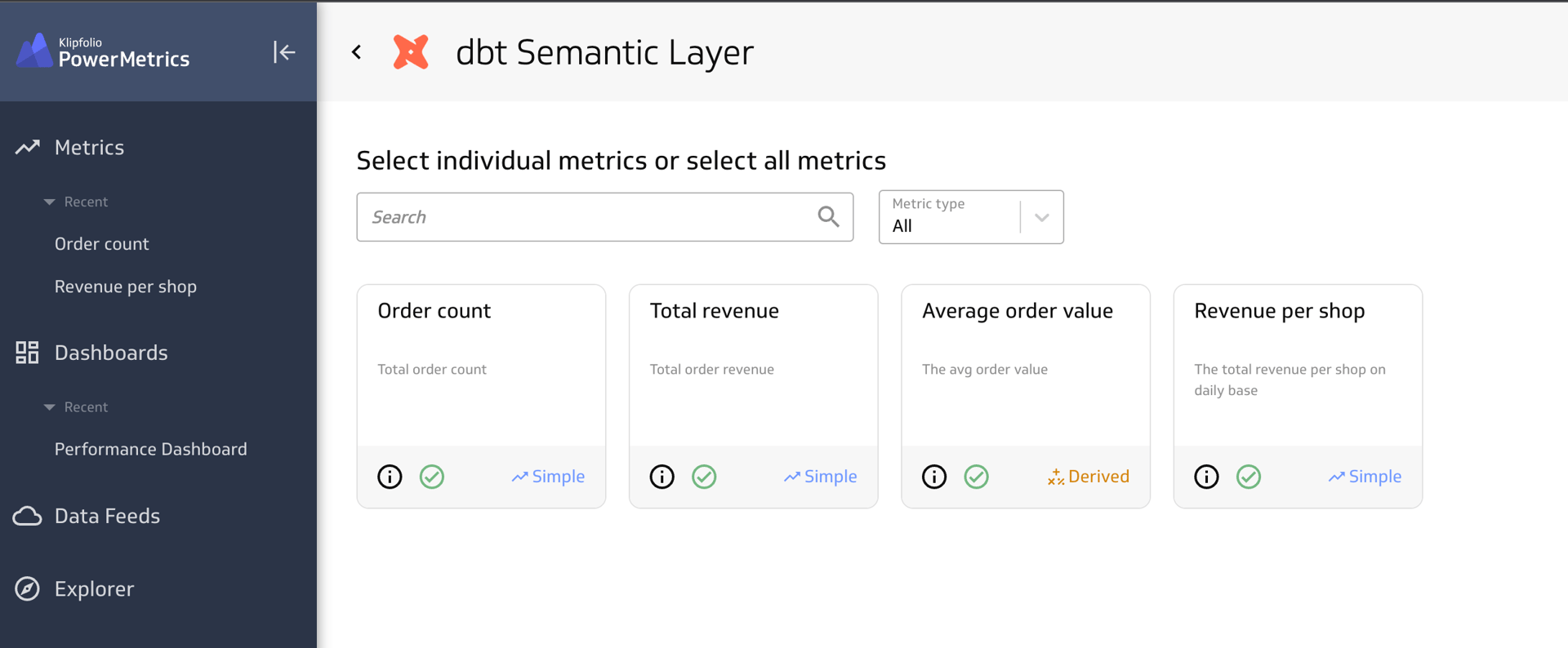Maximizing Business Insights: The Power of dbt’s Semantic Layer with Klipfolio PowerMetrics
Published 2023-11-27, updated 2024-05-03

Summary - Integrating dbt's Semantic Layer with Klipfolio PowerMetrics transforms data analytics. dbt enhances data model precision, while Klipfolio offers effective metric visualization. This synergy streamlines processing, decision-making, and is cost-effective.
Introduction
In the ever-evolving world of Data Analytics, the combination of certain tools can be a game changer. Recently, I had the opportunity to implement dbt's new Semantic Layer in combination with Klipfolio PowerMetrics, a fusion that promises to revolutionize data analytics. This article aims to share the benefits and my personal experiences with this setup, highlighting how it can be a transformative asset for businesses. Note that this piece is not a step-by-step guide but rather an exploration of the potential and advantages this combination holds.
Overview of dbt's Semantic Layer and Klipfolio's PowerMetrics
The dbt Semantic Layer serves as a robust foundation for data modeling, enabling businesses to define and manage their data models efficiently. Klipfolio PowerMetrics offers a dynamic way to visualize, interact with, and catalog metrics. These two technologies pave the way for more intuitive, insightful, and more important, accessible data analytics. Let’s take a closer look at both.
Unveiling the dbt Semantic Layer
The new dbt Semantic Layer, allows for defining core business metrics under version control, which can then be queried from a reporting solution such as Klipfolio PowerMetrics. This new capability aims to bring enhanced levels of collaboration and coherence to the modern data stack. The development of dbt's Semantic Layer was motivated by the need for consistent and precise metric definitions, which were difficult to achieve with pre-aggregated metrics due to limitations in flexibility and reporting.
The dbt Semantic Layer addresses this tradeoff between precision and flexibility in data analytics. It maintains the dimensionality of data without the need for pre-aggregated tables in data warehouses, thus offering a more dynamic data infrastructure. Under the hood this solution acts as a data infrastructure, via dbt Cloud, that rewrites and compiles queries en route to the data warehouse. This ensures precise and flexible metrics without materializing aggregated data in the warehouse.
The dbt Semantic Layer acts as a unifying layer for the modern data stack, integrating various BI, Data Science, and data-loading tools. It aims to bind different data tools around shared definitions for core business entities and metrics. It enhances the understanding of data models by exposing how tables relate to each other and to business metrics, thereby improving trust and consistency while expanding flexibility in the data stack.
More details about the Semantic Layer can be found in dbt's recent blog post.
Empowering BI with Klipfolio PowerMetrics
PowerMetrics was developed to address the need for clean, trusted data across all teams and make data analysis easier for non-technical teams. It's a BI solution purpose-built for metric creation and consumption, facilitating reliable, self-serve access for data and business teams. The development of PowerMetrics was driven by the limitations of traditional BI tools, which often failed to provide a single source of truth and struggled with complex data visualizations.
PowerMetrics adds essential components to the modern data stack including support for the dbt Semantic Layer, a metrics layer and a metrics catalog. These components enable business users to understand and visualize data more independently and effectively. The metrics layer includes standardized data definitions, adding semantic meaning to raw data. It also enables access to data sources outside of a data warehouse, such as files, spreadsheets, and cloud-based services.

Features like data feeds separate data queries and modeling from the metric definition, enabling data to be brought in from any source. This provides flexibility and facilitates data feed and metric governance. PowerMetrics maintains a knowledge graph to define relationships between metrics, enabling powerful exploration and analysis. Dynamic data segmentation helps in analyzing data from multiple perspectives. PowerMetrics is organized around a metrics catalog; a starting point that allows users to find and then visualize the right metrics and dashboards easily. This aids in making data teams and business users self-sufficient with metrics.
By combining a metrics layer, metrics catalog, and visualization capabilities, PowerMetrics aims to complete the modern data stack, providing a comprehensive BI solution for both data and business teams.

More in-depth information about PowerMetrics can be read in this blogpost or on the website.
My Journey with dbt's Semantic Layer and Klipfolio's PowerMetrics
Theory is one thing, but what about practical application? I recently had the chance to explore the combination of dbt's Semantic Layer and Klipfolio PowerMetrics first hand. To begin, we developed an ecommerce dataset in Google BigQuery, centered around a fictional chain selling Dutch stroopwafels (syrup waffles). This dataset, which included details on orders, products, and customers, was used to create standard data models in dbt, materialized as BigQuery tables. These models formed the basis for the Semantic Models within the Semantic Layer.
Implementing the Semantic Layer was straightforward overall, though I did encounter some challenges with features that were less documented.
- Contrary to the official guidelines, I found that SQL queries can't currently be used in the `expr` of Entities, Measures, and Dimensions within a Semantic Model. After discussing with dbt, they clarified that this functionality isn't supported yet but may be in the future.
- Additionally, calculations beyond basic aggregations like SUM, COUNT, and COUNT_DISTINCT need to be done in a separate data model, which can then feed into a Semantic Model.
- It's also important to note that before adding the Semantic Layer to a dbt Deployment Environment, the environment requires a successful job run.
- Moreover, the `name` attribute within and across Semantic Models must be unique. Be cautious when selecting the appropriate names, as altering the `name` attribute after the metric has been imported into PowerMetrics will disrupt the connection between PowerMetrics and the Semantic Layer.
Within these models, defining Entities (unique keys), Measures, and Dimensions is essential as these attributes are used to create Metrics as models in dbt. Our `orders` Semantic Model, for example, includes several keys, and aggregations under Measures, and Dimensions.

Metrics are available in four variants:
- Simple - Points directly to a Measure and takes only one Measure as input;
- Derived - Allows you to do calculations on top of two or more metrics;
- Cumulative - Aggregates a measure over a given time window. If no window is specified, it accumulates the measure over all time;
- Ratio - Creates a ratio out of two metrics. This involves defining a numerator metric and a denominator metric.
In one instance, we calculated the Average Order Value as a Derived Metric by dividing total revenue by order count.

This integration of data models, Semantic Models, and Metrics results in a comprehensive lineage in dbt Cloud’s Explorer.

Linking Klipfolio PowerMetrics was a smooth process. To deploy the Semantic Layer in dbt, you first generate a Service Token. This Token, along with the Environment ID, is then utilized in Klipfolio to connect the Semantic Layer to PowerMetrics.
After saving this connection, you have the option to set up a Webhook. This step is crucial in a CI/CD setup for ensuring seamless data synchronization between the Semantic Layer and PowerMetrics. You can find more information about this integration in this article.

PowerMetrics promptly displays all available Metrics from the Semantic Layer, allowing users to choose which Metrics to incorporate. Once selected, these Metrics are accessible in an intuitive interface, enabling users to delve deeper into each metric. Here, you can leverage specified Measures and Dimensions to glean the insights you're after. Each metric can be added to dashboards, providing a clear, comprehensive overview and deeper understanding of the insights generated.


The Power of Combining Klipfolio and dbt
The integration of dbt's Semantic Layer with Klipfolio PowerMetrics is not just about bringing two technologies together; it's about creating a synergy that enhances the overall value of data analytics. This combination allows for more streamlined data processing and more dynamic data visualization. During my experience, I found that the ease of accessing and interpreting data significantly improved, enabling quicker and more informed decision-making processes.
Imagine a world where, for data teams, defining and querying core business metrics is as simple as writing a line of code. This is the vision brought to life by dbt's Semantic Layer. Set to revolutionize the modern data stack, this innovation promises unparalleled collaboration and coherence.
It's a game-changer, acting as a unifying force in the data stack, seamlessly integrating various BI and data tools. And the best part? It integrates beautifully with Klipfolio PowerMetrics.
PowerMetrics enables self-serve, reliable data access for both data and business teams. At its heart lies the metric-centric approach, transforming raw data into business insights. With innovative features like data feeds and a robust knowledge graph, PowerMetrics not only brings in data from any source but also masterfully defines the intricate relationships between metrics. But, what truly sets it apart is its user-friendly approach. PowerMetrics empowers business teams to become self-sufficient in metrics, offering them a clear, visual understanding of data.

Conclusion
Integrating Klipfolio PowerMetrics with dbt's Semantic Layer offers a significant benefit for BI teams and organizations who want to encourage independent data analysis.. This combination harnesses the power of centrally-modeled data, ensuring a unified understanding of metrics across all members of your team or organization. It not only streamlines data interpretation but also aligns everyone with a consistent view of your key metrics.
Considering the capabilities of these two tools, their combination is surprisingly cost-effective. This advantage is particularly noticeable when compared to more comprehensive, and thus more expensive, solutions like Tableau and Google’s Looker (not to be confused with the free Looker Studio) who also offer out-of-the-box semantic model features.
Businesses will benefit from this flexible and powerful system that doesn't strain their budgets. It offers a customizable approach to data analytics, accommodating the unique needs of different businesses. The flexibility to adapt and scale according to client requirements makes it an attractive option. This combination is more than just two tools; it's a complete, modern data stack solution, fostering better decisions with clean and consistent data. Here we find the future of Analytics Engineering — a future where data is not just numbers, but a coherent story told through precision, flexibility, and user-friendly tools.
We will delve into more details on how to implement and use Klipfolio PowerMetrics and the dbt Semantics Layer in more articles to come.
i-spark: The Partner for Implementation
We at i-spark have been one of the first Implementation Partners of Klipfolio worldwide, delivering affordable reporting solutions to our clients based on best-of-breed cloud technology, such as dbt Cloud, for years.
Our team at i-spark not only possesses deep technical expertise in these tools, but we also understand the unique business contexts in which they operate. By choosing i-spark, organizations benefit from a tailored approach that blends innovative technology with our experience, ensuring a seamless integration that maximizes the potential of your data. Whether it's enhancing data accuracy, improving decision-making processes, or gaining a competitive edge, i-spark is the partner that can turn these goals into reality.
Related Articles

Metrics provide rich context for better AI: Introducing the new PowerMetrics AI experience
By David Mennie — June 21st, 2024

PowerMetrics - New data warehouse integrations and Cube semantic layer support
By David Mennie — June 14th, 2024

Partner Case Study: Eyeful
By Cathrin Schneider — May 21st, 2024

Partner Case Study: The Project Booth
By Cathrin Schneider — April 11th, 2024
